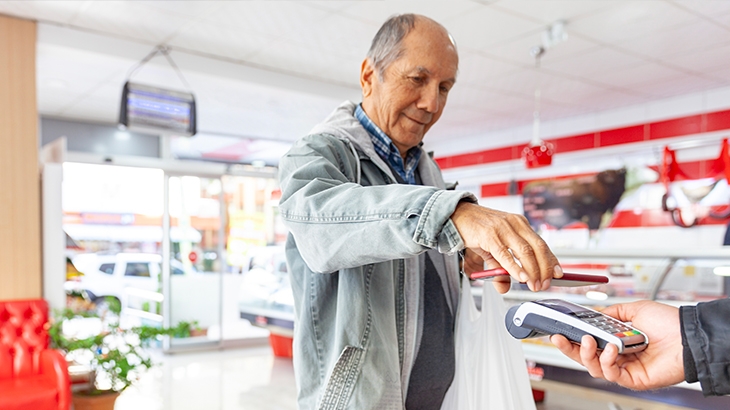How to Protect Your Debit Card from Fraud
If you're like us, you probably use your debit card daily. Whether shopping, paying bills, or taking out cash, using your card can leave you susceptible to fraud. It might seem impossible to keep your debit card information safe from fraud and theft, but we've got a few ways that can reduce how often you experience debit card fraud.

Know How and When Your Bank Will Contact You
All banks have to follow the same federal regulations, so they have similar policies on how and when they'll contact you. Usually, that's with an email, text, or phone call to alert you of any suspicious transactions, sometimes before they allow a transaction to go through. Talk to your bank about what to expect when (not if) debit card fraud happens to you and what communication will look like so you can avoid scammers pretending to be from your bank. If they can tell you what number the text or phone call will come from, that's even better! Save that number as a contact in your phone so you know if a call or text is legitimate.
Information Your Bank Will Never Ask You For
When you're on the phone with your bank, they might ask for things like the address you have on file to verify that it's really you that they're talking to, but there are other things they will never ask for. Your bank will never ask for your PIN number, your full card number, CVV number on the back of your card, one-time passcodes sent to your phone for any reason (such as logging in to your online banking account), your full account number, or any of your passwords. If they do, hang up and call your bank immediately at the phone number listed on their website. Never call the phone number provided in a text message or email if you suspect it may be fraud.
What to Do if You Get an Unexpected Call About Debit Card Fraud
While banks do make calls to customers to notify them of potential fraud, it can be easy to get caught up in the moment. Take a deep breath, listen to what they have to say, and don't give any information they ask for. If you can, check your transaction history in your bank's app while they're on the phone and look for the transactions they're talking about. If you don't see any, this is a fraudulent phone call. If you do, don't hesitate to hang up and call your bank back at the phone number listed on their website to ask about fraud on your card. This way, you can protect yourself from potential scammers and handle the situation if you need to. Your bank representative will not be upset with you for protecting yourself.
Tips to Prevent Debit Card Fraud
Use a Digital Wallet
Whether you use Apple Pay, Google Pay, or Samsung Pay, a digital wallet is a great way to keep your debit card information safe. Learn more about how digital wallets work and have peace of mind that your card information is safe since all of them encrypt your card information. Plus, it's a convenient and quick way to pay wherever contactless payments are accepted. It's also easy to add your debit card to your digital wallet. Even if you don't use a digital wallet, always practice smartphone safety and set up a passcode or biometric data to open your phone and protect your information. With everything we do on our phones, having an extra layer of security just makes sense.
Use a Strong, Unique PIN
A strong PIN will help prevent thieves from taking out cash at an ATM. Avoid easily guessable numbers like your birth year and sequential numbers like 1234 or 1111. Instead, create something random that you can easily remember.
Monitor Your Transaction History and Bank Statements
If you don't set up transaction alerts, review your purchase history and bank statements regularly, at least once a week, using your bank's app. If you see anything suspicious, report it to your bank immediately so they can investigate the issue and stop further fraud.
Set Up Transaction Alerts and Controls
Setting up alerts is easy, and you can set them to alert you of any transactions over a dollar amount or those made from retailers you select so you'll know the minute fraud occurs. Turn them on and change them any time as you see fit. Your bank might also offer ways to restrict your debit card so it can't be used in selected ways. For example, you might be able to set a restriction that doesn't allow transactions over a specific dollar amount or from certain retailers in categories such as travel or restaurants.
Be Cautious with Your Debit Card Online
Online shopping is convenient, but it does carry some risks. Never shop online using public Wi-Fi because your information can be stolen by fraudsters using the same network. Additionally, use the guest checkout rather than creating an account so the site you're shopping on doesn't save your card information, which is at risk if the site gets hacked. Lastly, consider using a credit card for online purchases to keep the money in your bank account safe. When you use your credit card this way, immediately make a payment for the same amount (even if you don't see the transaction on your card right away) so you don't go into debt.
Secure Your Physical Debit Card
Your card information isn't just susceptible to fraud when used online—your physical card can also be vulnerable. A few steps to protect your physical card include carrying your debit card in a safe space (not your back pocket or an unzipped bag), shredding any old documents that have your card number on them, and reporting a lost or stolen debit card as soon as you notice it's missing. If you think you misplaced it, most bank apps have a feature where you can temporarily turn off your debit card. If you find it later, you don't have to wait for a new one if you use that feature. If you don't find it, just call your bank and request a new one.
Check ATMs and Card Readers for Skimming Devices
Skimming devices are commonly found at places like gas station card readers and stand-alone ATMs. When you insert your card to make a transaction, the skimmer will send your card information (with your PIN number if you used it) directly to fraudsters. Next time you go to the gas station or somewhere it might be easy to place a skimming device, look closely at the card reader before doing anything. If it's loose or the keys feel spongey or too thick, use cash or go to a different gas station altogether. Tap-to-pay is also a good way to avoid card skimmers since you don't have to swipe or insert your card, and they provide the same protection level as chip readers.
What to Do if Your Debit Card Has Fraud
When you realize your card or bank account has fraud, it's important to report it to your bank as soon as possible. This will minimize your own losses, as you must report any fraud to your bank within 60 days after you're sent the statement showing the unauthorized transaction. You may be given what's called provisional credit while the bank investigates the fraud, which they may take back after the investigation closes. Your banker can explain the process and policy in detail, so ask as many questions as necessary to understand what to expect.
- Turn off your debit card within your banking app, if you can (like in the WaFd Bank app)
- Visit your branch or call your bank directly at the phone number listed on their website
- Report the fraudulent charges or activity
- Order a new debit card or ask if your branch can create a new one for you
Report it to the Federal Trade Commission so they can use the information to build a case against scammers and prevent future scams
WaFd Bank is Here to Help
Our friendly bankers are here to help you keep your money and your good name safe with products and services to make banking easy. WaFd is also here for any questions about scams, money, and more, and no question is too small. We also offer checking accounts that come with rewards to help you save money and stay on top of your finances, not to mention great-looking debit cards so you can spend in style. To learn more, take a look at our checking account options, open an account online, stop by your local branch, or give us a call at 800-324-9375.
Did you find this article helpful? Share it!


